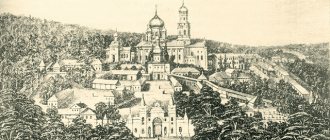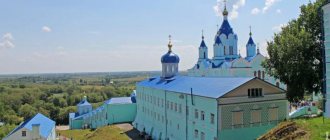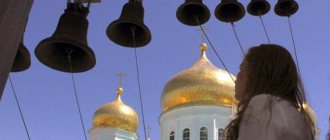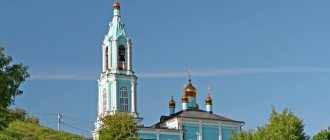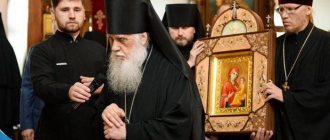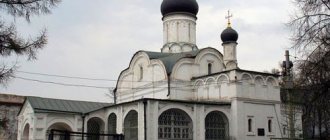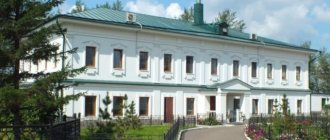| Putivl Molchensky Monastery. Photo from 2009 from the site sobory.ru |
Molchensky Monastery in honor of the Nativity of the Blessed Virgin Mary in Putivl
, convent of the Konotop diocese
- Address: Ukraine, 41500, Sumy region, Putivl, st. Seimskaya 1/1
- Tel.: 8 (05442) 9–17–99
- Official site:
- On the map: Yandex.Map, Google map
Monastery-fortress
According to legend, the name of the monastery comes from the icon that appeared in the Molche swamp.
The Putivl Monastery itself arose as a metochion of the Sophronievo-Molchensk Monastery. There is information that already in 1519, within the boundaries of the Putivl fortress, there was a two-story temple that belonged to the ancient Sophronievo-Molchensk Hermitage and was its courtyard. At the end of the 16th century, a stone citadel was built in Putivl on the site of an ancient Russian wooden fort. It was called the Kremlin and was hexagonal in plan, with round corner towers and a square gateway. The relatively low walls had three tiers of loopholes. The French traveler Jacques Margeret, having visited Putivl, wrote: “In Russia, castles and fortresses are wooden, with the exception of Moscow, Smolensk, Ivan-Gorod, Tula, Kazan, Astrakhan and Putivl...”
In 1591-1593 The monastery compound in Putivl turns into an independent monastery, becoming the defense and religious center of the city of Putivl.
Thanks to the powerful fortifications of the Putivl fortress, the monastery was not destroyed during the devastating raid of the Crimean Tatars on the northern lands in 1592.
A certificate located in the monastery archive testifies that in 1597 the Putivl Molchensky Monastery had estates, lands, and an assigned church in the name of Saints Florus and Laurus in different places.
In the fall of 1604, Putivl surrendered to False Dmitry I, who entered the city after being defeated by the troops of Boris Godunov in the Battle of Dobrynichi.
The residence of False Dmitry in Putivl became a stone fortress, or more precisely, the Cathedral of the Nativity of the Blessed Virgin Mary of the Molchensky Monastery. The impostor's room, a “secret octagonal chamber,” was located in the upper tier of the cathedral’s main tower.
For four months, while in the Molchensky Monastery, he sent out charming letters,” in which he informed the people about his “miraculous salvation” and called on them to fight Boris Godunov. Having gathered a new army (40 thousand people) in Putivl and its environs, the impostor in 1605 moved to Moscow.
When the Sophronie Hermitage was plundered by the Polish gentry, led by an impostor, then Abbot Paphnutius with the remaining small brethren moved to the Putivl Monastery, as to a place completely safe from various enemy devastations. All the remaining shrines: icons, church utensils, etc. were transferred to the Putivl Monastery. The very place where Pustyn used to stand and all the land it owned were now assigned to the Putivl Monastery. But the most expensive treasure brought by Abbot Paphnutius was the Molchensk Icon of the Mother of God. Since then, the Putivl Monastery began to be called the Great Molchensky Monastery
and also merged
the monastery of the “White Mother of God”
from a stone church, whitewashed and built according to legend by “the Rastriga, who called himself Tsarevich Demetrius.” Others claim that this church was built by a certain Greek Ilya.
During the “time of troubles”, between 1606 and 1612, the Molchensky Monastery burned down several times, was rebuilt and was re-consecrated in 1630. At the turn of the 17th-18th centuries it was greatly reconstructed. The building acquired the features of Ukrainian Baroque.
At the end of the 17th century, having lost its significance as a border fortress, Putivl fell into decay, the fortress city turned into a provincial, provincial town. Along with the city, the Molchensky Monastery also fell into decay. During the reign of Catherine II, he lost his estates, lands and peasants. And it was transferred to the status of a “3rd class monastery.” This gave the right to maintain only a small staff in the monastery: the abbot and 12 monks.
Over time, new buildings appeared in the monastery. A two-tier bell tower was erected, complementing the architectural complex of high-rise silhouettes.
In the 1720s, the abbot's chambers and the fraternal building were built. At the end of the 18th and beginning of the 19th centuries, a theological school operated in the monastery. In the 1860s, construction began on a warm church, a refectory, and a building of cells.
One of the last abbots of the monastery, Sosthenes, wrote:
“The regular 3rd class monastery is located at the end of the city, which sits on a steep and elevated spire with cliffs on one side near the river, and on the east above the mouth of the Krynka River. All along the hill to the slope of the mountains around the monastery, fruit and wild trees of various quality grow. From all sides of the monastery, local types of natural formation are presented in a charming and delightful arrangement, and especially on the southern side, two significant and deep rivers are presented around the eyes, and behind them Lake Khatysh. Near these rivers and behind them, a hay meadow of different owners runs for several miles; during spring, a large area is flooded with hollow water. All the way to the monastery it is covered with melt water and at this time it seems like the sea, and the monastery appears to be standing above the water in its grandeur.”
In the early 1920s, the monastery was devastated and looted, and the extensive library and iconostasis were destroyed in a fire. The monastery was abolished. Fraternal buildings, churches, and utility buildings were used for a vocational school, an orphanage, warehouses, and then there was a radio components plant for the military-industrial complex.
Revival of the monastery
In 1987, the Molchensky Monastery (or rather its remains) became one of the key objects of the Putivl historical and cultural reserve.
In 1992, the monastery was returned to the Church. Here, like many centuries ago, a male monastery was located.
On March 30, 1995, the Holy Synod of the Ukrainian Orthodox Church blessed the opening of the monastery [1].
On October 28, 1997, by decision of the Synod of the Ukrainian Orthodox Church, the status of the monastery was changed, it became female [2].
Restoration work is underway on the sister building, the temple, and utility rooms. Daily services are held in the monastery church.
Used materials
- History on the website of the Molchensky Monastery:
[1] Journal No. 38 of the meeting of the Holy Synod of the Ukrainian Orthodox Church dated March 30, 1995 // Website of the Synodal Commission of the Ukrainian Orthodox Church for Monastic Affairs -
[2] Journal No. 56 of the meeting of the Holy Synod of the Ukrainian Orthodox Church dated October 28, 1997 // Website of the Synodal Commission of the Ukrainian Orthodox Church for Monastic Affairs -
[3] “Gerontius (Khovansky)”, information and reference portal on schism studies Anti-Raskol
, April 7, 2011,
[4] “Monastery in honor of the Nativity of the Blessed Virgin Mary Molchensky (female)”, Russian Orthodoxy
,
Shrines and patronal holidays of the Molchensk monastery
Today the Molchensk monastery is known as a place of world pilgrimage. This unique monument of Orthodoxy and world culture, which currently houses a convent, continues to be restored.
Important! The list of the Zhirovitsk Icon of the Mother of God, transferred to the Putivl Museum, as well as the Smolensk Icon of the Mother of God, are still in an unknown place, their traces have been lost, but God's grace has never left this place of prayer.
Of architectural and historical value are:
- bell tower, a monument of the 16th-17th centuries;
- refectory building, the construction of which dates back to the 16th-19th centuries:
- a warm church and the home of the metropolitan.
In the second half of the 19th century, the warm Church of the Nativity of John the Baptist was erected.
The shrine of the monastery, which attracts pilgrims with its miraculous qualities, is the Molchenskaya Icon of the Most Holy Mother of God, which has protected this region since 1405.
Every year, thousands of parishioners gather on May 7 to celebrate the patronal feast day in honor of the transfer of this miraculous face and on October 1, the day of the appearance of the icon in the Molchensk Hermitage.
Molchenskaya miraculous icon of the Mother of God
On July 7, the monastery holds a solemn liturgy in honor of the Nativity of John the Baptist.
The time of services can be checked on the main website of the monastery https://molchensky-monastyr.org.ua/
Sights of Putivl
Sofronievsky Monastery
Two kilometers from the village of Novaya Sloboda, Putivl district, on high hills above the flat floodplain of the Seim, among an oak forest, there is a unique complex of the Sofronievsky Monastery (formerly the countryside Molchansky Monastery).
According to chronicles, it was founded in 1405, and received its name from the huge impassable swamp Molche, in the floodplain of the Seim. Initially, all the buildings of the monastery were wooden. At the end of the 16th century, the monks founded their compound in the Putivl Kremlin, and then, in connection with the events of the so-called “Time of Troubles,” at the beginning of the 17th century they finally moved to Putivl. The monastery in the forest was abandoned, and only in the 30s of the 17th century the first stone Church of the Nativity of the Virgin Mary was built there. Under Abbot Sophronia from 1653, the monastery expanded greatly. Many new buildings appeared, and in order not to confuse it with the Putivl Molchansky Monastery, it was given the name Sophronium Hermitage. By the middle of the 18th century, the Sofronievsky Monastery had turned into a large complex complex, which consisted of civil and religious buildings from various periods of construction.
To date, three above-ground structures have survived: the refectory of the late 17th century, the gateway Church of the Intercession, built in the mid-18th century, the abbot’s building from 1911, and partly the fence with a gate.
The expressive silhouette of the gate church greets the traveler coming out to the edge along the forest road. The church is two-tiered. The first tier has a passage arch in the center and arched doorways on the sides. The second tier is a very slender three-part one-domed temple in the spirit of “Elizabethan Baroque”, with lush architraves over the windows, curved cornices and an elegant Baroque dome top.
To the left of the gate church, on a separate hill, you can see the rectangular building of the refectory. It is one-story, with a semi-basement, and has a very interesting system of vaulted ceilings. In particular, the refectory hall on the first floor has two pillars. This is the only example of this kind in Ukrainian architecture. The external decor of the refectory is austere and laconic.
In contrast, the rector’s building, built in the neo-Russian style with richly profiled cornice rods, platbands, and various semi-columns, amazes with its wealth of decorations. The most complex decorative details are made with high precision from shaped bricks, which indicates the highest quality of construction work.
However, the most interesting part of the Sofronievsky Monastery is underground. And the point is not only that even with a cursory inspection, the bases of walls and the foundations of many structures are visible in the ground. On the eastern slopes of the two monastery mountains there are several cave complexes dug in loess soils, similar to the famous caves of the Kiev Pechersk Lavra. They are still practically unexplored. Experts date the oldest of them to the 13th-14th centuries. Cave labyrinths consist of passages, cells, and niches-arcasolia for burials. Large rooms are also available. Apparently these are underground churches and chapels.
Another very interesting circular underground labyrinth is located on the southeastern slope of the monastery mountain, almost at the very surface. Its walls and vaults are lined with brick, which dates back to the 18th century. The most unusual thing here is the vaulted underground church. Its vaults are tightened with iron ties laid in the masonry. This is indisputable evidence that this labyrinth was built in an open way: first they dug a large pit, built vaulted passages and cells from brick, and then covered it all with earth.
The caves of the Sophronievsky Monastery await explorers. They still keep many secrets.
Transfiguration Cathedral
1617-93 The Transfiguration Cathedral (first half of the 17th century) is a work of ancient Russian architecture. Its most ancient part - the main cubic mass - is crowned with five decorative onion-shaped heads on narrow round neck-drums. It is surrounded on three sides by a closed one-story porch (to the northern wall of which is adjacent a single-apse, single-domed chapel), and on the fourth, eastern side, one low apse protrudes. Thus, from the rather low volumes of the porch, chapel and apse, a mighty cube of the main temple seems to grow. The planes of its facades are divided by four slender, thin semi-columns, intercepted by several also thin belts, and end with a wide multi-broken cornice with a blank wall above it, like an attic, decorated with decorative arches imitating zakomaras, a characteristic detail of ancient Russian architecture. Built as the main temple of the Holy Spirit Convent, founded in the 16th century. Wonderful iconostasis and paintings. Together with the church it creates a unique ensemble. (Lunacharsky St.).
Its history is complex and confusing, its beginning is lost in the depths of centuries. Initially it was a maiden monastery of the Holy Spirit, which was first mentioned in archival documents dating back to 1595. In 1617, construction of a stone cathedral began here, which continued until the end of the century - a classic example of long-term construction. Finally, having lost patience, Abbess Anisya in 1697 complained about the builders to Peter I, who not only gave the necessary orders, but also named the officials and builders responsible for delaying construction work. With grief in half, by 1707 all construction work in the monastery was completed. An ensemble emerged consisting of buildings that have survived to this day. In 1770, the monastery was abolished, and its buildings were transferred to the city's Spassky Cathedral.
In the center of the territory, behind a stone fence with a monumental gate and surrounded by centuries-old trees, stands a snow-white cathedral. It is topped with five onion-shaped heads. This type of temple is typical for Moscow architecture of the 17th century. The high-rise tetrahedral volume contrasts with the squat porch, gallery, apses, and chapel surrounding it on all sides. Despite the monumental size of the building, it is very elegant. The walls of the main high-rise volume are dissected by narrow semi-columns, the windows are placed in two tiers, framed by platbands of the finest sculptural work.
The interior of the cathedral amazes with the height and scope of the internal space, which is generously illuminated by numerous windows. The walls inside are whitewashed, and against this background the five-tiered iconostasis, rising to the very ceiling arches, looks very beautiful. In composition, it belongs to the type of Russian iconostasis: horizontal cornices and vertical carved gilded columns on a dark red background form a rectangular grid in which icons are placed. The craftsmen introduced some local features into the composition of the iconostasis. For example, the royal doors have a characteristic Ukrainian opening with the upper corners cut obliquely. The vine climbing on the columns and framing the icons is typical of Ukrainian Baroque. The icons are of particular interest. In 1907, the iconostasis was restored and, under the supervision of the Imperial Archaeological Commission, re-gilded. It should be noted that in Left Bank Ukraine there are no iconostases of the 17th century left at all, so the Putivl iconostasis is unique of its kind.
In the center of the cathedral, on a long iron chain, hangs a silver chandelier, made in 1692 in Nuremberg and donated to the cathedral by Peter I. It has a clearly Baroque character. It is also emphasized by the design of the brackets. The lower ball is decorated with an incised pattern reminiscent of the decor of Ukrainian jewelry of the 17th century. This suggests that an “outline”, that is, a drawing of a chandelier made by one of the Ukrainian masters, was previously sent to Nuremberg.
The interior of the cathedral contains inscriptions written in Church Slavonic script. These are rare examples of monastic tombstones from the 17th century. They were found in the ground in 1899 during a major renovation of the cathedral and then embedded in the wall. At the southern wall of the cathedral there is a large black cross. This is the grave of Ivan Ryabinin (1834-1912), historian and local historian, author of numerous works on the history of Putivl, most of which have not yet lost their significance.
Cross Exaltation Gate Church-bell tower
To the south of the cathedral is the gate church of the Exaltation of the Cross. The structure, asymmetrical in composition, was built in 1697-1707 as the gate church of the Holy Spirit Monastery. Like all gate churches, it is two-tiered. Above the western porch, as a superstructure of the third tier, rises a powerful octagonal bell tower, topped with a flat tent and a small dome. A two-story extension to the west, which visually balances the asymmetry of the composition, was erected in 1764. This architectural monument is characterized by simplicity, grandeur and power of forms. The rough architecture of the gate church-bell tower is in clear contrast with the sophistication of the cathedral. But at the same time, the church is not static, like a cathedral, but has strong dynamics: the architectural masses grow gradually from the low apse through the central volume with a high roof and decorative dome to the octagonal bell tower. Moreover, the bell tower once had defensive significance, as evidenced by the loopholes at the base of the octagon.
An interesting page in the history of Putivl is connected with this building. According to local legends, after the second Streltsy revolt, Peter I exiled Princess Sophia to Putivl, imprisoning her in the maiden monastery of the Holy Spirit. She was placed on the first floor of the gate church in a cell to the right of the gate. By order of Peter I, she was “under a strong guard,” but this seemed to him not enough, and in Holland, by order of the monarch, chimes were made, which struck every minute with a loud, monotonous chime. They were installed under the windows of Princess Sophia’s cell so that she would not forget about her “dear brother” for a minute. However, Peter soon realized that it was unsafe to keep Sophia in Putivl. After all, it was Putivl that in previous centuries was often the center of popular uprisings, and Sophia could become a kind of “banner” for the Putivl rifle regiments. Therefore, the princess was taken away from Putivl, and the chiming clock, after many ups and downs, ended up in the Molchansky Monastery in the 19th century. According to contemporaries, their every-minute battle irritated both the hosts and the guests until they were finally broken.
Nicholas Kozatsky Church
The 17th-18th centuries enriched Putivl with several more first-class architectural monuments. Among them, a special place belongs to the Church of St. Nicholas the Cossack, built at the expense of the residents of Putivl - the Ukrainian Cossacks. Its slender two-tower silhouette is visible from afar, from many surrounding streets. The paradox of this remarkable building lies in the two towers of equal height. The fact is that the temple was originally built in 1735-1737 in three parts and with one top, and much later, in 1770, a multi-tiered bell tower was added to the church from the west, disturbing the balance of the silhouette of the monument. The building is modeled after Russian churches and has two floors. On the ground floor, called the basement, there was a warm church where church services took place in winter. The low vaults with strippings covering it, with an abundance of light, create an atmosphere of almost homely warmth and comfort. In contrast to this, the upper, so-called cold church, where services were held in the summer, was designed. Through the arch there is a view of the high central top, the edges of which, narrowing in perspective, create the illusion of a fantastic, unattainable height.
The temple was built by a Russian architect, as evidenced by its design design. But since the customer of the temple was the Ukrainian community of Putivl, the master was given the favorite type of Ukrainian single-domed temple as a model. The architect not only created a building of magnificent proportions and an expressive silhouette, but also very subtly took into account the peculiarities of visual perception of architecture: the windows of the first tier, located at eye level of a person standing on the ground, are decorated with exquisite, finely profiled platbands with figured torn pediments. All other windows located above the level of human height do not have any decorations.
The Church of St. Nicholas the Cossack is one of the remarkable monuments of the Ukrainian Baroque, indicating that professional architecture developed under the certain influence of folk traditions, tastes and ideas.
It is interesting to note that the restoration of the monument was recently completed. Now the museum’s exhibition “The Lay of Igor’s Campaign” is being created there.
Spadshchansky forest
15 kilometers west of Putivl lies the Spadshchansky forest - the cradle of the partisan movement in the Sumy region, the birthplace of the partisan army, which fought from Putivl to the Carpathians under the command of twice Hero of the Soviet Union S.A. Kovpak and Hero of the Soviet Union S.V. Rudneva.
At the edge of the forest, visitors are greeted by the “People's Avengers” stele. From here a winding forest road leads to the former partisan base.
In the forest, in a large clearing, there is a neat building of the Museum of Partisan Glory, and not far from it is the Monument to Partisan Glory. The twilight and dampness of the former partisan dugouts, located surrounded by swamps, will tell about the hardships and deprivations of the courageous people's avengers more than the most vivid descriptions, and the mass grave of the Kovpakov partisans will remind you of the price paid for the freedom and independence of the Motherland. In the forest, at the detachment’s base, the dugouts of the operational groups, miners, headquarters, the partisan kitchen, the dugout of the medical unit have now been restored... And next to the museum there are partisan trophies - a cannon, a little further in the forest clearing - a tank.
On the eve of the celebration of the 40th anniversary of the Great Victory, the sculptural Alley of Heroes was opened in Spadshchansky Forest. Bronze busts of Heroes of the Soviet Union - S.A. - stood at an eternal post under the shade of birch trees. Kovpaka, S.V. Rudneva, P.A. Vershigory, P.A. Kulbaka, D.I. Bakradze, P.E. Braiko, S.P. Tutuchenko, V.A. Voitsekhovich, A.N. Lenkina, A.K. Cymbalom.
Spadshchansky Forest has been declared a historical and cultural reserve.
Stele "People's Avengers"
Sculptor A. Ivchenko, architect N. Makhonko, 1971.
The monument represents the origin and organization of a partisan unit consisting of separate detachments. Chaotically scattered stones, grouping and enlarging, grow into a mountain, from which a monolithic wall is born, stone to stone, a symbol of the unity and unshakable strength of the people. Protruding from the wall are the sculpted faces of men, women, old people, children - those who became a wall on the path of the fascist invaders.
Monument to Partisan Glory
A unique emblem of the reserve is the monument to partisan glory - a sculpture of a partisan on a high pentagonal pylon. The monument was created by sculptor B.N. Nikonchuk and architect S.P. Tutuchenko in 1971.
The monument is a high faceted pedestal with a sculpture of a partisan installed on it. The monument is symbolic. The five sides of the pylon represent the five united partisan detachments. The figure is depicted in motion - having stepped towards the enemy, the partisans block his path with a machine gun at the ready.
Museum of Partisan Glory
The Museum of Partisan Glory is dedicated to the heroic pages of the partisan movement in the Sumy region.
It was opened in September 1956 in the Spadshchansky forest near Putivl in a small wooden building built on the site of a forester’s house burned by the Nazis on October 19, 1941. Since 1971, the museum has been housed in a new building.
A The exhibition in the first hall includes photographs, documents, personal belongings, and weapons of the people's avengers. The originality of partisan life is conveyed by the model of a partisan dugout. The materials in the second hall are dedicated to the unparalleled courageous raid of Sumy partisans together with the military brothers-in-arms of the formation of Hero of the Soviet Union A.N. Saburov to Right Bank Ukraine. Schemes and photographic documents transport museum visitors to the context of the heroic “rail war” that unfolded in the vastness of Ukraine at that terrible hour when the Battle of Stalingrad was taking place on the banks of the Volga.
The third and last room is dedicated to the most legendary page of the military feat of the Kovpakovites - the Carpathian raid.
The basis of the museum exhibition is photographic documents taken during military campaigns by partisan cameraman Boris Vakar. He died a brave death in the Carpathians. Based on his filming, the film “The Legend of Spadshchansky Forest” was created - a worthy monument to the cameraman and his comrades in arms.
Monument at the entrance to Putivl
When approaching the city from Sumy, guests are greeted by a monument to a partisan and a partisan. On the pedestal there is an inscription: “City of Partisan Glory” (the authors of the monument are sculptor A. A. Ivchenko, architect N. P. Makhonko).
In the difficult hour of trials that befell the country, Putivl revived its glory as a warrior city and became the cradle of the partisan movement in the Sumy region. The feat of the Kovpakov partisans who carried out the legendary raid from Putivl to the Carpathians is written in golden letters in the history of World War II. ...At the beginning of July 1941, the Putivl district party committee began to form partisan detachments and underground groups. One partisan detachment under the command of S. A. Kovpak was supposed to operate in the Spadshchansky forest, another, commanded by S. V. Rudnev, in the Novoslobodsky forest, the third, led by S. F. Kirilenko, in the Maritsa tract. On September 8, 1941, the partisan detachment of S.A. Kovpak set out for the Spadshchansky forest. On October 18, S.V. Rudnev’s detachment also arrived here.
In the first months of the fascist occupation, underground Komsomol groups began working in the city. The core of one of them consisted of senior students from city secondary school No. 1. The group was led by the former pioneer leader of the school, Valentina Georgievskaya. Komsomol members distributed among the population handwritten anti-fascist leaflets and reports from the Sovinformburo, which they received via radio, collected information about the composition and armament of the fascist garrison in Putivl, preparing punitive expeditions and repressions, and transmitted this information to the partisans. The second underground group was led by Alexander Kovalenko. Young patriots committed acts of sabotage, distributed leaflets, and took out weapons. : At the end of November, Nazi units arrived in the city specifically to fight the partisans. On December 1, 1941, about three thousand German soldiers and officers, supported by artillery and mortars, began an attack on the Spadshchansky forest. There were only 73 people in the detachment at that time.
The battle lasted about 10 hours. But all the attempts of the fascists to break the resistance of the partisans were in vain. Neither the cavalry, which the punishers abandoned to cut off the group of Kovpakovites from the main part of the defenders, nor the frequent attacks helped. In the same winter, the Glukhovsky, Konotopsky, Shalyginsky, Krolevetsky partisan detachments joined the Putivl partisan detachment. A union of people's avengers of the Sumy region was born.
It's been a difficult few months. In May 1942, a partisan unit under the command of S. A. Kovpak and S. V. Rudnev, already numbering almost 700 fighters, received the task of intensifying acts of sabotage on enemy communications and, for this purpose, entering the Putivl region to attack the Konotop railway - Divination. As a result of a rapid offensive, the partisans defeated enemy garrisons on the right bank of the Kleven River - in the villages of Vyazenka, Strelniki, Yatsyno, Staraya Sharpavka, Spadshchina. On May 26, 1942, the Kovpaks liberated Putivl and held it for two days. And in October of the same year, having broken through the enemy blockade created around the Bryansk Forest, a formation of partisan detachments from the Sumy region launched a raid on the right bank of the Dnieper. At that time, there were 1,160 people in the unit.
During the raid on Right Bank Ukraine (from October 26 to November 30, 1942), S.A. Kovpak’s formation covered 750 km behind enemy lines through the Sumy, Chernigov, Gomel, Kyiv, and Zhitomir regions. The partisans blew up 26 bridges, derailed 2 trains, destroyed over 970 fascists, 5 armored cars, 17 vehicles. On June 12, 1943, the formation of S.A. Kovpak and S.V. Rudnev set out on a raid in the direction of the Carpathians to strike the enemy in the area of Drohobych and Stanislav (Ivano-Frankivsk). The main oil refineries and large oil reserves were concentrated here. During the Carpathian raid (July-October), the Kovpakov soldiers fought four thousand kilometers, disabled four oil refineries and 13 oil storage facilities, blew up dozens of oil rigs and released 50 tons of oil from the oil pipeline, destroyed 14 railway and 38 horse-drawn bridges, and destroyed more than three thousand Hitler's soldiers and officers.
Monument to S.A. Kovpak
In 1971, when the 30th anniversary of the partisan movement in the Sumy region was celebrated, a monument was erected to twice Hero of the Soviet Union Sidor Artemovich Kovpak (authors: People's Artist of the USSR M.G. Lysenko, sculptor V.V. Sukhenko, architects S.P. Tutuchenko, A.F. Ignashchenko).
The sculptural image of the partisan general is installed on a concrete pedestal in the form of a pyramidal rock seven meters high. S.A. Kovpak is depicted in a long fur coat, a hat, felt boots, and with a pipe in his hand. The monument is opened towards the Sejm.
Nikolskaya Gorka
Facilities
Cathedral of the Nativity of the Blessed Virgin Mary
The Cathedral of the Nativity of the Virgin is a hybrid of Ukrainian and Naryshkin baroque.
It is crowned with three octagons - above the main volume, the chapel and the altar, with decor in the style of Moscow churches of the 17th century. The cathedral was erected in 1602-1604 as a courtyard of the suburban Sofronievskaya Hermitage. In addition to the church function, it also performed a defensive function. Since the cathedral was erected in the middle of a cramped fortress courtyard, built up on all sides, it was necessary to combine in its building a barn - in the basement and in the basement, a refectory and kitchen - in the basement, a cathedral and a warm church - on the second tier, a combat chamber with loopholes - on the third tier , above the altar.
The architectural plan of the building has three extraordinary features: the altar is in the form of a square tower rather than a semicircular apse; the defense chamber on the third tier of the altar is crowned with a tent; covering the basement of the nave with a system of cross vaults with a pillar in the middle. This composition is rare for Ukrainian architecture. The cathedral belongs to the type of multifunctional religious buildings adapted for defense, which are called “fortress churches.”
In 1612, the cathedral was damaged by fire, after which it was extensively rebuilt in 1630-1636. The following reconstructions took place in 1666–1669, 1778, and 1860s, when a one-story library building was built into the cathedral.
The building has features characteristic of Moscow architecture of the 17th-18th centuries with manifestations of the Ukrainian architectural type, gravitating towards high-rise tower-like compositions.
It was closed in the mid-20s along with the monastery. In 1921, there was a fire here, after which the cathedral gallery and library had to be dismantled. In the second half of the 40s - early 50s of the XX century, within the cathedral in honor of Saints Zosima and Savvaty of Solovetsky Wonderworkers, it was allowed to hold divine services.
The especially revered shrines of this temple include the miraculous icon of the Movchanskaya Mother of God (1724) returned to the monastery in 1995; a small shrine with the relics of the Holy Saints, the icon of the Most Holy Theotokos “Quench My Sorrows” (XVIII century), the icon “Trinity” (XIX century), the image of the “Ascension” (XIX century) and others.
Gate bell tower
Originally it was a fortress gate tower and was erected approximately in the same period as the walls and corner towers where in 1602-1604. In 1700 the tower was rebuilt. Now nothing reminds us of the defensive nature of this building.
Defensive walls with corner tower
These walls are the remains of the stone fortification of Putivl. The walls themselves are internal, directly surrounding the monastery territory, and external, along the road to the Seim.
Refectory
The refectory is a quadrangular one-story building built in the first half of the 19th century over casemates adjacent to the ancient fortress wall with a corner round tower.
Warm Church of St. John the Baptist
Built in 1866-1869 by architect David Grimm in the Russian-Byzantine style on the site of a dilapidated temple of the same name built in 1602-1604. At the heart of the structure is a monastery wall with casemates, which is clearly visible in the basement of the building. The church was closed in the mid-20s of the 20th century along with the monastery. In the 1930s, the temple underwent significant reconstruction and became similar to a civil building.
Abbot's corps
Erected in the 1720s-1730s, with reconstructions in the 19th-20th centuries. The structure is based on a fortress wall and buildings from the early 17th century. At first, the monks' cells were located here on the first floor and the abbot's chambers on the second. Subsequently, the building was occupied by the Putivl Spiritual Consistory.
Other
To the west of the gate bell tower, closer to the city, there are buildings of a utility yard and two stone hotel buildings, rebuilt in the post-war years. During the 90s of the 20th century, they were partially returned to their original forms.
The monastery mountain is pierced by caves and underground passages. Some of them were dug at the same time as the construction of the defensive monastery. In the 19th century, Polish coins from the early 17th century were found in these caves.

